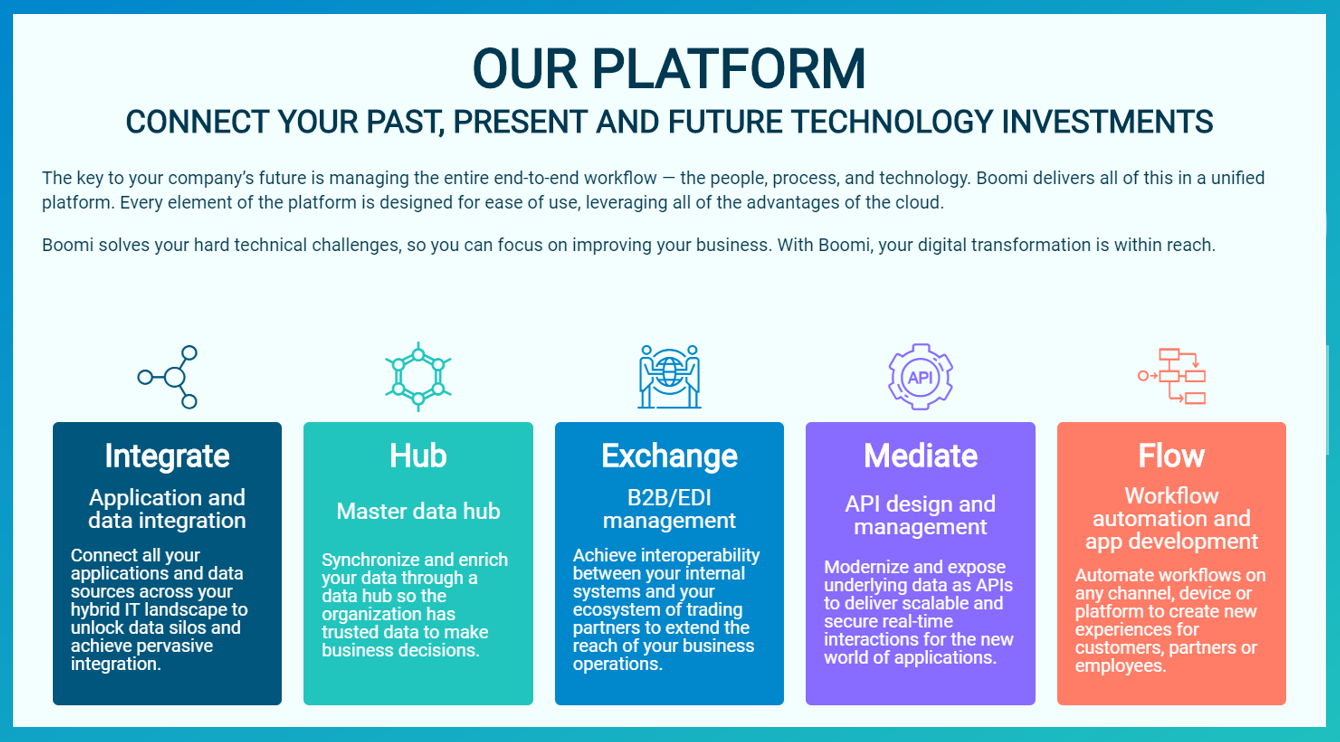Dell Boomi Broadens iPaaS To Offer a Unified Integration Platform for Digital Transformation
Dell Boomi’s latest iPaaS update showcases the company's intent to deliver a broader, one-stop ‘unified integration platform,’ that can solve a widening range of digital transformation challenges. IDN explores Dell Boomi’s Spring 2018, with updates for IoT, data governance and workflow apps, with Div Manickam, group product and solutions marketing manager.
by Vance McCarthy
Tags: API, cloud, Dell Boomi, IoT, integration, iPaaS, workflow apps,

group product and solutions
marketing manager

"We’re bringing the ability to go ‘top-down’ or ‘bottom-up’ into one [integration] platform. We think this solves our customers' needs much more strongly than anything we’ve done so far."
Dell Boomi’s latest iPaaS update showcases the company's move to broaden its offering to deliver a one-stop ‘unified integration platform,’ aimed at solving a widening range of digital transformation challenges.
Dell Boomi’s Spring 2018 cloud-based integration platform sports 100+ integration-savvy updates for IoT, data governance, workflow apps and more.
“Integration will always be our core,” she added. “But in the age of digital transformation, with changes all around, we now have an ability to position integration as a more sexy thing,” Dell Boomi’s Div Manickam, group product and solutions marketing manager told IDN.
Certainly, IoT has become one of the more ‘eye-catching’ topics in 2018.
For Boomi, IoT success requires “integration capabilities that can provide a more holistic, end-to-end and real-time views of what happens to all that data,” “Having IoT data is great, but it doesn't always give you everything you need. We are here to help make sense of that data.”
To that end, Boomi Spring 2018 adds IoT-savvy features for last-mile integration with device data, as well as ways to quickly build, deploy and automate workflow apps and processes powered by IoT data. Boomi’s latest release combines data integration, data management and process apps, Manickam said, adding “as a result, we have the ability to not just connect to those devices. We have the ability to help customers actually make sense for that data quickly and easily.”
Boomi Spring 2018’s support for IoT projects aims to be deep and wide, with features for:
Edge device support – IoT integration patterns require seamless integration of device data, application data and people. The Boomi Atom, a lightweight runtime engine, now can also provide a flexible and scalable execution engine for edge devices. The Boomi Atom allows customers to run integrations, and host and manage web services, anywhere--on-premise, in clouds or edge devices.
IoT Protocol Support – Boomi now supports a variety of IoT connectivity protocols, including open standards such as AMQP, MQTT and REST. Customers can leverage this support to move data to data lakes and other stores, as well as feed such data directly into cloud and on-premise applications.
Workflow Automation for IoT – Thanks to vertical integration, organizations can also use Boomi Flow to create business processes and / or workflow apps based on the edge IoT data. Such apps can respond to custom-set alerts or triggers to allow for automatic actions or human decisions.
Environmental IoT Management – Because IoT deployments can often consist of hundreds of thousands of devices distributed across a large landscape, Boomi engineers note that IoT projects often need multiple edge gateways that perform common application integration functions. Boomi Environment Management will allow customers to create, update and delete application integration processes once, and the changes will automatically synchronize across all Boomi Atoms lightweight runtime engines (and associated gateways) that belong to an environment. Further, with Boomi Environment Management, IoT integration processes can be built, tested and promoted between environments with a full audit trail of what was deployed, and by whom.
All that said, the Boomi cloud-based platform will not store the IoT data. “We are only processing the data as we need to be, so the data skill sets in those Edge devices.” she added.
One user of Boomi’s IoT support is Cary, North Carolina. “Boomi has helped us more quickly detect traffic signal issues and automate processes necessary to orchestrate the people needed to resolve the issue,” said Terry Yates, a leader of Cary’s smart city project in a statement.
Boomi’s Push for a Unified Integration Platform – End-to-End Productivity, Data Synch, Workflow
Integration & APIs
 Enterprise-Grade Integration Across Cloud and On-Premise
Enterprise-Grade Integration Across Cloud and On-PremiseBeyond IoT support, Boomi Spring 2018 also adds other upgrades to complete its vision as a “unified integration platform” for digital transformation tasks.
Developer Productivity: To promote developer productivity and ease-of-use. Boomi Spring 2018 adds “packaged deployments” in a nod to embracing CI/CD practices. Specifically, its redesigned deployment workflow supports user-defined versioning and ensures that a version stays with the package when it is deployed or shared. “This has many benefits, especially for simplifying auditing and governance,” Manickam told IDN.
Boomi Spring 2018 is also encouraging efficient collaboration among customers and Boomi third-party partners. As an example, Boomi intends the update to make it easier for partners to build Boomi Connectors through support for sharing templates and code via Boomi Community Share. This ‘share’ feature builds on Boomi’s Process Library, allowing developers and integration architects publish and share their code examples and templates across the Boomi network.
Extend API Use via Authentication Broker: Boomi also adds an authentication broker to better support API management. It lets users create one authentication source, and then deploy it across multiple external sources.
“The authentication broker in our previous release actually helped customers [work with] third party external sources. Now you have an ability to bring multiple external sources together,” she said. “So, you have an option to do multi-node [integrations] and increase that flexibility. It’ll give you a more agile business driven approach, not just a fixed blueprint-driven solution.”
As Boomi continues to broaden support for expanding API programs and hybrid IT landscapes, it also added Swagger 2.0 and WSDL support. “Now you can actually take any external URL and automatically generate API endpoints,” Manickam said. “We have always been looking at APIs because we needed a quick 2-step, 3-step to expose that data and create REST, SOAP and OData from those integration processes. . . This is our first step toward that to automate the API endpoints, the next steps will be towards gateway capabilities,” she added.
Process, Workflow Apps: Boomi Spring 2018 also takes on integration for process and workflow apps. Boomi Flow, component for creating low-code apps and automated workflows, in this version extends its file management and database support.
This means Flow users can now access, retrieve, load and save files from any source accessible to the Boomi platform, as well as make changes in those files. Users can also save them for consistency and access from any application integrated with Boomi, regardless of where those files are residing in the organization.
Boomi Flow also adds capability to manage various aspects of legacy on-premise databases or cloud databases. The result: The entire process of accessing a database and all load, save, delete operations, whether for a specific row or table or for many records, can now be achieved from Boomi Flow – all while leveraging the under-the-covers capabilities of Boomi’s integration platforms and connectors.”
Data Synchronization, Governance: As Boomi does more to support more complex exchanges for apps, APIs and data from hybrid systems, helping customers keep track of all that data has emerged as another big focus moving forward.
“Another challenge we see with customers is their need for data synchronization and data governance,” Manickam said. “They need to share their many types of data with multiple apps and people. But to do that they need to be sure they know where their single source of truth is.” That focus on business data is a main reason why we’ve also made Master Data Hub a core component to our platform.”
That said, Boomi’s not positioning the platform’s Master Data Hub capability as a pure enterprise-wide MDM (master data management) solution. It’s simply meant for those integration and data sharing projects using the Boomi unified platform, Manickam added.
“The way we look at it, once a customer solves their integration problems, they then would use the [Master Data] Hub to address those challenges to bringing all that information together.”

Digital Transformation is Driving A ‘Different Paradigm for Integration’
“As we’ve been talking with customers this year, one of the things that came to our realization is a question: Are we looking at a different paradigm for integration-- or a totally new one?” Manickam said. Customers are looking for more services to support their digital transformation, and much of what they’re looking for is driven by integration.”
In answering this question, Boomi engineers and execs came to the conclusion that what was needed is a ‘unified platform’ model was what was needed. Manickam said this model would provide both ‘top-down’ and ‘bottom-up’ options (including interfaces) that should appeal to business managers, app developers, as well as traditional integration specialists.
“We know we have an opportunity to go from the business process down to the integration infrastructure. Flow starts at the very top and talks to the business. The other way, which is more what we have done so far , is to start with core integration [platform services] first and then move to the top,” Manickam said.
“Interestingly, we are seeing both those things happen. So, we’re bringing the ability to go top-down or bottom-up into one platform. We think this solves our customers' needs much more strongly than anything we’ve done so far.”
While integration professionals look for technologies to connect Application A to Application B, businesses think of integration another way, Manickam said. “They will say, ‘I have this problem. How can you solve it for me?’ Those business [users] are not really worried about what the underlying technology is, as long as the technology does what it says it can do.”
Related:
- Tray Advantage Program To Speed, Simplify AI-Powered Automation for Enterprises
- Removing Barriers to Business by Enabling Agility & Control with Ecosystem Integration
- 98% of Enterprises Struggle To Maintain, Rebuild Integrations for Key Business Apps
- ThreatX Adds API Visibility, Protection Capabilities To Defend Against Real-Time Attacks
- Visibility and Transparency are Climbing the List of C-Suite Priorities in 2022
All rights reserved © 2025 Enterprise Integration News, Inc.


